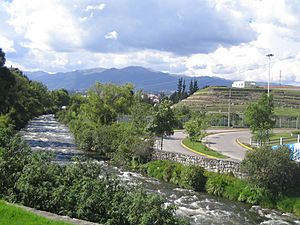Tumebamba facts for kids
Tumebamba (also spelled Tomebamba or Tumipampa) was a very important city in the old Inca Empire. Its name in the Kichwa language means "Knife Field." The great Inca ruler Huayna Capac (who ruled from 1493 to 1525) chose Tumebamba to be the northern capital of his empire.
Sadly, the city was mostly destroyed during a big fight between two brothers, Huáscar and Atahualpa. This happened just before the Spanish explorers, called conquistadors, arrived in 1532. Today, the Spanish city of Cuenca, Ecuador is built right on top of where Tumebamba used to be. But you can still see parts of the old Inca city at special places called Pumapunku and Todos Santos.
History of Tumebamba
Before the Incas took over, the area around Tumebamba was called Guapondelig. The local people, called the Cañari, had lived there for at least 500 years.
The Inca emperor Topa Inca Yupanqui (who ruled from 1471 to 1493) added this area to the Inca Empire. It took a lot of hard work and many battles against the Cañari people. His son, Huayna Capac, was probably born in Tumebamba. He was responsible for building most of the Inca structures in the city.
Huayna Capac wanted Tumebamba to be a grand northern capital for the Inca Empire. He designed the city to look a lot like Cuzco, which was the main Inca capital. Huayna Capac even had a royal palace built there for himself.
There are old stories from the Spanish that say Huayna Capac had huge building stones brought all the way from Cuzco to places like Tumebamba. In 2004, archaeologists found proof of this! They found stone blocks in Ecuador that came from a quarry near Cuzco. These scholars found 450 stones, some weighing up to 700 kilograms (about 1,540 pounds) each.
These stones traveled more than 1,600 kilometers (about 1,000 miles) on Inca roads. These roads went through the tall and rugged Andes mountains. The Incas did not have animals to pull carts or wheeled vehicles. So, people had to move these heavy stones all by themselves! This huge task shows how important Tumebamba was to Huayna Capac. He wanted it to be a second capital for his empire.
One expert said that these stones showed how power and importance were moved from the main capital to Tumebamba. Moving them was also a big public display of how the Inca government controlled its workers. The Incas also got building stones from a place called Cojitambo, which was about 18 kilometers (11 miles) away.
Around 1525, Huayna Capac and many other Incas died from a disease. It was probably a sickness brought by Europeans. After he died, his sons Huascar and Atahualpa fought over who would be the next emperor. Many battles in this civil war happened near Tumebamba. The Inca city was mostly destroyed during these fights. The Cañari people had supported Huascar, so Atahualpa treated them very harshly.
Pumapunku and Todos Santos Sites
A Spanish writer named Pedro Cieza de León visited Tumebamba in 1547. He wrote that "Everything has crumbled and in ruins but you can still appreciate how grand it was." The city of Cuenca was built on top of the old Inca city. So, most of the old ruins are now buried.
Two parts of the Inca city still remain today. These are the ruins of Todos Santos and Pumapunku (sometimes called Pumapongo). These two sites are very close to each other, about 300 meters (984 feet) apart. They are also near the Tomebamba River.
These sites do not have the very finely carved stones that you see in Cuzco. This might mean that these places were not the most important parts of the Inca city. The main temple and plaza might be hidden under the newer buildings of Cuenca. At Pumapunku, workers found tools for spinning thread. This suggests that the site might have been a home for aclla. These were special women chosen by the Incas who lived apart from others. There is also a large man-made water pool, terraces, and canals. These look similar to those at Quispiguanca, which was a royal estate of Huayna Capac near Cuzco.
The Manuel Agustín Landivar Museum is right next to the Todos Santos ruins. The Pumapongo Museum and Archaeological Park is at the Pumapunku ruins. Both museums have exhibits about the Indigenous people of the Americas, the Cañari, the Inca, and the first Spanish settlers.
See also
 In Spanish: Tomebamba para niños
In Spanish: Tomebamba para niños



